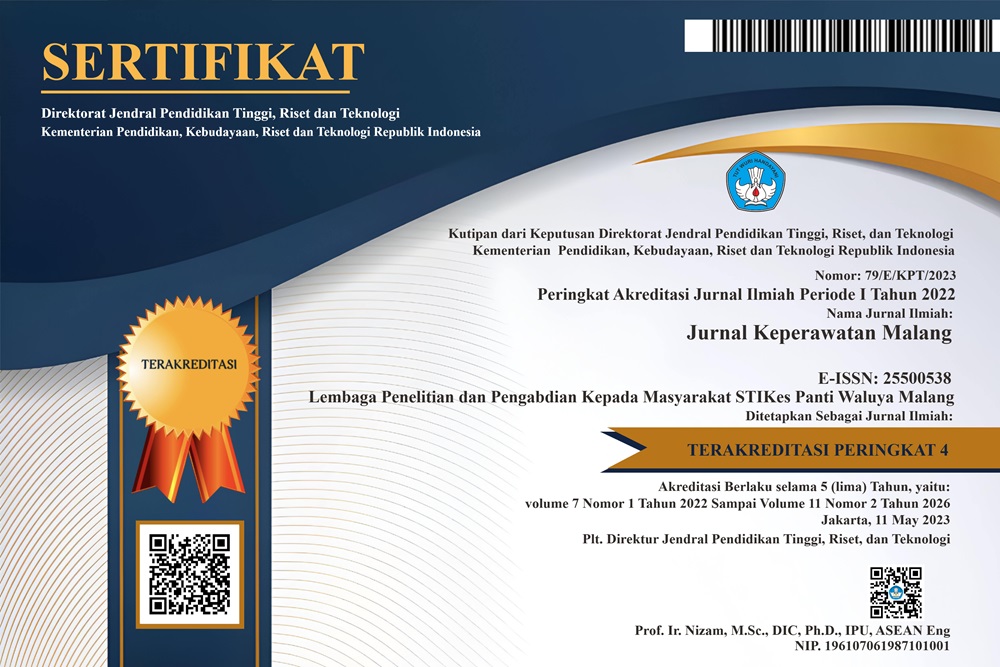The Effect of Structured Discharge on Family Readiness to Provide Transient Care for Stroke Patients
DOI:
https://doi.org/10.36916/jkm.v9i1.283Keywords:
anxiety , deep breathing relaxation, Family , ICU, Nature Relaxation SoundAbstract
Background: Every situation that occurs in the ICU, whether in critical conditions or life-threatening conditions, can make the patient's family feel anxious. A combination of natural relaxation sounds and deep breathing relaxation is one of the non-pharmacological therapies that could help reduce anxiety
Purpose: Understanding the effect of the combination of natural relaxation sounds and deep breathing relaxation reduces anxiety among families of patients in the waiting room at RSUD'S ICU of Ulin Banjarmasin
Methods: With a quasi-experimental pre and post-test without control design using consecutive sampling techniques involving 29 respondent families of patients in the ICU waiting room, the questionnaire utilized the HARS (Hamilton Anxiety Rating Scale). Bivariate analysis employed the Wilcoxon Test to analyze the impact before and after the intervention was administered
Result: In the data analysis, a significance value of 0.000 (p < 0.05) was obtained, with Ha accepted, indicating the combination of natural relaxation sounds and deep breathing relaxation can reduce the anxiety levels among families of patients in the waiting room at RSUD'S ICU of Ulin Banjarmasin
Implication: The decrease in the anxiety levels among families of patients before and after the intervention with natural relaxation sounds and deep breathing went from severe anxiety (63.3%) to mild anxiety (53.3%). The research results indicated that 10 respondents experienced a decrease in scores of more than 10 points. Therefore, this intervention can be utilized.
References
Baker, M. S., Hidayati, L., & Kurnia, I. D. (2020). Kepuasan Pasien dalam Pelaksanaan Discharge Planning. Fundamental and Management Nursing Journal, 2(2), 55. https://doi.org/10.20473/fmnj.v2i2.13386
Camicia, M., Lutz, B. J., Harvath, T. A., & Joseph, J. G. (2021). Using the Preparedness Assessment for the Transition Home after Stroke Instrument to Identify Stroke Caregiver Concerns Predischarge: Uncertainty, Anticipation, and Cues to Action. Rehabilitation Nursing, 46(1), 33–42. https://doi.org/10.1097/rnj.0000000000000267
Coupland, A. P., Thapar, A., Qureshi, M. I., Jenkins, H., & Davies, A. H. (2017). The definition of stroke. Journal of the Royal Society of Medicine, 110(1), 9–12. https://doi.org/10.1177/0141076816680121
Damawiyah, S., & Ainiyah, N. (2018). Efektivitas Penerapan Perencanaan Pulang Dengan Metode Terstruktur Terhadap Kesiapan Keluarga Dalam Memberikan Mobilisasi Dini Pada Pasien Cerebro Vaskuler Attack Di Rs. Islam Surabaya. Journal of Health Sciences, 10(1). https://doi.org/10.33086/jhs.v10i1.148
Gitlin, L. N., & Rose, K. (2014). Factors associated with caregiver readiness to use nonpharmacologic strategies to manage dementia-related behavioral symptoms. International Journal of Geriatric Psychiatry, 29(1), 93–102. https://doi.org/10.1002/gps.3979
Hagedoorn, E. I., Keers, J. C., Jaarsma, T., van der Schans, C. P., Luttik, M. L. A., & Paans, W. (2020). The association of collaboration between family caregivers and nurses in the hospital and their preparedness for caregiving at home. Geriatric Nursing, 41(4), 373–380. https://doi.org/10.1016/j.gerinurse.2019.02.004
Katan, M., & Luft, A. (2018). Global Health Neurology. Seminars in Neurology, 38, 208–211. https://doi.org/10.1159/000441085.lifetime
Kemenkes RI. (2018). Stroke Dont Be The One (p. 10).
Lutz, B. J., Young, M. E., Creasy, K. R., Martz, C., Eisenbrandt, L., Brunny, J. N., & Cook, C. (2017). Improving Stroke Caregiver Readiness for Transition from Inpatient Rehabilitation to Home. Gerontologist, 57(5), 880–889. https://doi.org/10.1093/geront/gnw135
Morphology, T. C. (2021). Tanda dan Gejala Stroke.
Nurrandi, S. R., & Putri, T. A. R. K. (2021). Family Experience as Caregivers in the Rehabilitation of Stroke Patients: A Literature Review. KnE Life Sciences, 2021, 736–744. https://doi.org/10.18502/kls.v6i1.8749
Pratiwi, M. D., & Rahmayani, F. (2021). HEMIPARESIS ALTERNANS?: LAPORAN KASUS. 9, 143–148.
Putri, T. A. R. K., Ramadita, W., Supriatin, E., & Hayati, S. N. (2022). Psychoeducational Intervention for Family Caregiver Burden in Stroke Patients Care. Risenologi, 7(1a), 21–25. https://doi.org/10.47028/j.risenologi.2022.71a.327
Putri, T. A. R. K., & Zuhri, A. S. (2022). Pengaruh Constraint Induced Movement Therapy Terhadap Kinerja Ekstremitas Atas Pada Pasien Pasca Stroke. Medical-Surgical Journal of Nursing Research, 1(1), 74–82. https://jurnal.hipmebijabar.com/index.php/jp-kmb/issue/view/1
Ramadhan, S., & Antika Rizki Kusuma Putri, T. (2022). The Effect of Bilateral Arm Training on Daily Activity in Stroke Patients. KnE Life Sciences, 7(2), 404–411. https://doi.org/10.18502/kls.v7i2.10334
Riskesdas. (2018). Laporan Provinsi Jawa Barat. In Lembaga Penerbit Badan Litbang Kesehatan.
Saraswati, D, R. (2021). Transisi epidemiologi stroke sebagai penyebab kematian pada semua kelompok usia di indonesia. Journal Kedokteran, 2(1), 81–86.
Downloads
Published
Issue
Section
Citation Check
License
Copyright (c) 2024 Tri antika rizki kusuma Putri, Riza Sukma Agustian, Suci Noor Hayati, Gina Nurdina, Tri Hapsari Retno Agustina, Susy Puspasari

This work is licensed under a Creative Commons Attribution-ShareAlike 4.0 International License.












